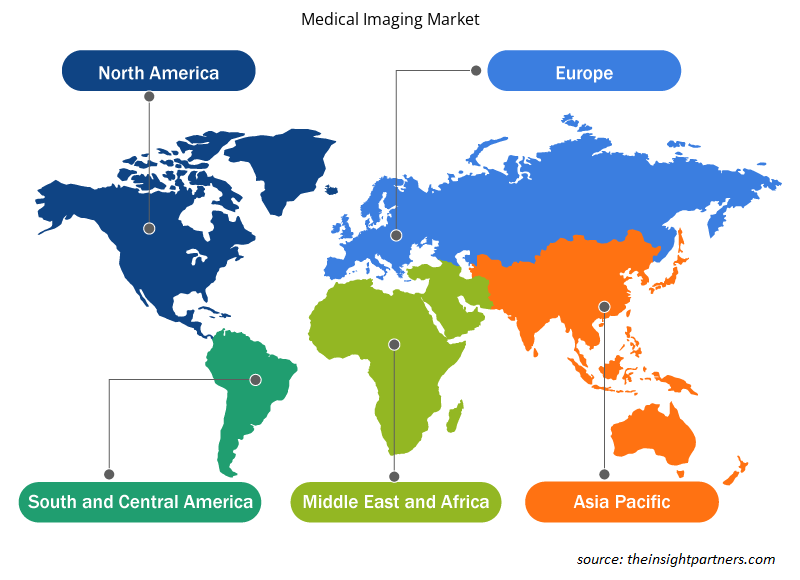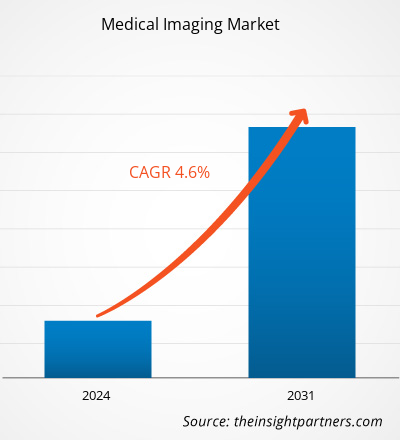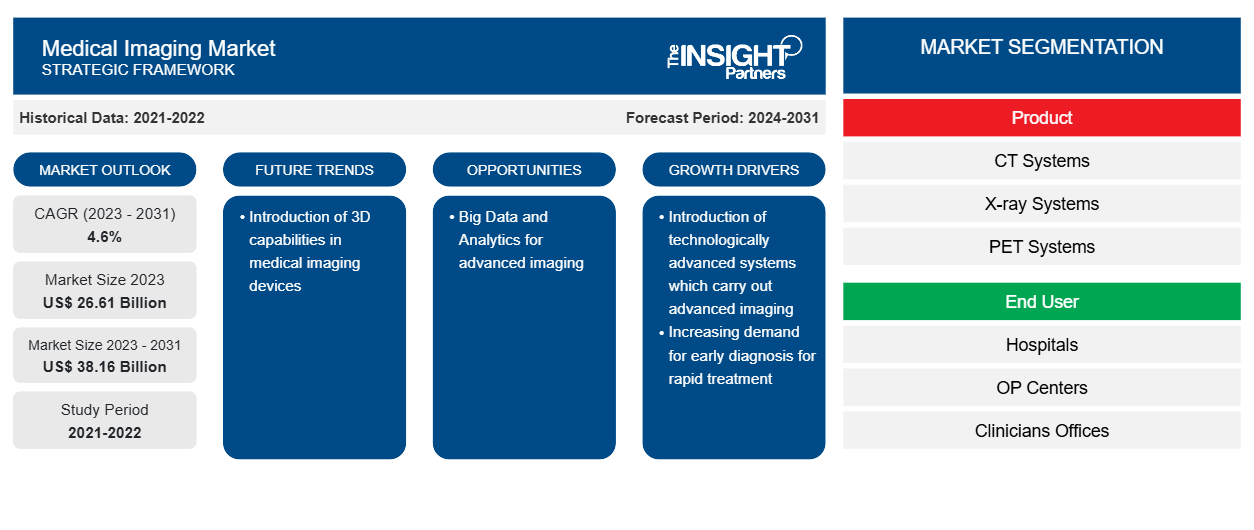من المتوقع أن يصل حجم سوق التصوير الطبي إلى 38.16 مليار دولار أمريكي بحلول عام 2031 من 26.61 مليار دولار أمريكي في عام 2023. ومن المتوقع أن يسجل السوق معدل نمو سنوي مركب بنسبة 4.6٪ خلال الفترة 2023-2031. ومن المرجح أن يظل إدخال قدرات ثلاثية الأبعاد في أجهزة التصوير الطبي اتجاهًا رئيسيًا في السوق.
تحليل سوق التصوير الطبي
إن الطلب المتزايد على التشخيص المبكر للأمراض وتوسيع نطاق التطبيقات السريرية، والنمو السريع للسكان المسنين، والزيادة اللاحقة في انتشار الأمراض المرتبطة بها ، والتقدم التكنولوجي في صناعة التصوير التشخيصي، وزيادة الاستثمارات والأموال والمنح من قبل المنظمات العامة والخاصة، كلها عوامل تعمل على تغذية نمو سوق التصوير الطبي. بالإضافة إلى ذلك، فإن المبادرات الحكومية لتعزيز التصوير الطبي للوقاية من الأمراض، وزيادة الاستثمار في أنشطة البحث والتطوير لتطوير التصوير الطبي المبتكر، وزيادة اعتماد التصوير الطبي في البلدان النامية تعمل على تغذية نمو حصة السوق.
نظرة عامة على سوق التصوير الطبي
من الناحية الجغرافية، من المتوقع أن تسجل منطقة آسيا والمحيط الهادئ أعلى معدل نمو سنوي مركب في الفترة المتوقعة 2023-2031. إن التركيز المتزايد على اللاعبين في السوق في تقديم التصوير الطبي المتطور تقنيًا لمختلف الأمراض يغذي نمو السوق. تحتل الهند المرتبة العشرين بين أكبر مصنعي الأجهزة الطبية على مستوى العالم وهي رابع أكبر مصنع للأجهزة الطبية في آسيا، تليها اليابان والصين وكوريا الجنوبية. من المرجح أن تشهد البلاد نموًا محتملاً على خلفية قاعدتها السكانية التي تزيد عن مليار نسمة، والوعي الصحي، والازدهار الاقتصادي، والخبرة التكنولوجية، وإثراء الموظفين المهرة، وتطوير المرافق نحو الصحة.
قم بتخصيص هذا التقرير ليناسب متطلباتك
ستحصل على تخصيص لأي تقرير - مجانًا - بما في ذلك أجزاء من هذا التقرير، أو تحليل على مستوى الدولة، وحزمة بيانات Excel، بالإضافة إلى الاستفادة من العروض والخصومات الرائعة للشركات الناشئة والجامعات
-
احصل على أهم اتجاهات السوق الرئيسية لهذا التقرير.ستتضمن هذه العينة المجانية تحليلاً للبيانات، بدءًا من اتجاهات السوق وحتى التقديرات والتوقعات.
محركات وفرص سوق التصوير الطبي
تزايد الطلب على التشخيص المبكر لصالح السوق
إن الاختبارات التشخيصية تشكل عنصراً أساسياً في نظام الرعاية الصحية، حيث توفر معلومات أساسية لتمكين مقدمي الخدمات والمرضى من اتخاذ القرارات السريرية الصحيحة. وتستند حوالي 75% من القرارات السريرية إلى اختبار تشخيصي. ويتزايد الطلب على الوصول إلى تشخيص أسرع وأكثر دقة بمعدل 10% سنوياً، مما يزيد من التكلفة ويضع ضغوطاً على قدرة مقدمي التشخيص. ومن وجهة نظر المريض، يمكن للاكتشاف المبكر والتشخيص أن يمنع الألم والمعاناة غير الضروريين. كما يمكن أن يقلل من نطاق وتكلفة العلاج. ويربط عدد كبير من الأبحاث التشخيص المبكر بفوائد صحية قابلة للقياس، مثل تحسين معدلات البقاء على قيد الحياة وانخفاض تكاليف العلاج. وعلاوة على ذلك، فإن الوعي الحكومي من شأنه أن يدفع نمو السوق بشكل أكبر. على سبيل المثال، تهدف حملات Be Clear on Cancer إلى تعزيز التشخيص المبكر للسرطان من خلال تعزيز الوعي العام بعلامات وأعراض السرطان وتشجيع الناس على زيارة طبيبهم العام دون تأخير. وتتولى هيئة الصحة العامة في إنجلترا مسؤولية البرنامج، بالتعاون مع وزارة الصحة وهيئة الخدمات الصحية الوطنية في إنجلترا. وبالتالي، فإن زيادة الطلب على التشخيص المبكر تغذي نمو سوق التصوير الطبي.
البيانات الضخمة والتحليلات بمثابة فرصة لنمو السوق
وفقًا لمقال نُشر على موقع ITN، ذكر دافال شاه وبراشانث كولايكال من شركة CitiusTech، والذي ناقش إمكانات البيانات الضخمة في التصوير التشخيصي، أن هناك ميزات جديدة ومثيرة للاهتمام في نظام معلومات الأشعة (RIS) وأنظمة PACS، وخاصة تلك الموجودة في السحابة. وقد تشمل هذه أيضًا تحليلات وتقارير رائعة عن البيانات التشغيلية والسريرية كما ورد في المقال. يتم استخلاص مؤشرات الأداء الرئيسية على مستوى المؤسسة (KPIs) من مجموعة متنوعة من المصادر. تُستخدم مؤشرات الأداء الرئيسية هذه بشكل عام لتناسب احتياجات المزود، مع مراعاة الكفاءة السريرية والتشغيلية بالإضافة إلى راحة المريض. على الرغم من استخدام مؤشرات الأداء الرئيسية هذه للتحسين لسنوات عديدة، إلا أنه يمكن قياس الكفاءة الإجمالية بسهولة ويمكن تحسينها من خلال الكفاءة التكنولوجية للأجهزة، وزيادة الوسائل، وأنظمة البرامج المتقدمة، والأجهزة المحمولة. وبالتالي، فإن التركيز المتزايد على استخدام بيانات العطاءات والتحليلات في التصوير الطبي يعمل كفرصة لنمو سوق التصوير الطبي.
تقرير تحليل تجزئة سوق التصوير الطبي
إن القطاعات الرئيسية التي ساهمت في استخلاص تحليل سوق التصوير الطبي هي المنتج والمستخدم النهائي.
- بناءً على المنتج، ينقسم سوق التصوير الطبي إلى أنظمة التصوير المقطعي المحوسب، وأنظمة الأشعة السينية، وأنظمة التصوير المقطعي بالإصدار البوزيتروني، وأنظمة التصوير بالرنين المغناطيسي، وأنظمة الموجات فوق الصوتية، وغيرها. احتل قطاع أنظمة الأشعة السينية أكبر حصة في السوق في عام 2023.
- بناءً على المستخدم النهائي، ينقسم سوق التصوير الطبي إلى المستشفيات ومراكز العيادات الخارجية ومكاتب الأطباء ومراكز الرعاية الطارئة. احتل قطاع المستشفيات أكبر حصة سوقية في عام 2023.
تحليل حصة سوق التصوير الطبي حسب المنطقة الجغرافية
ينقسم النطاق الجغرافي لتقرير سوق التصوير الطبي بشكل أساسي إلى خمس مناطق: أمريكا الشمالية، ومنطقة آسيا والمحيط الهادئ، وأوروبا، والشرق الأوسط وأفريقيا، وأمريكا الجنوبية والوسطى.
سيطرت أمريكا الشمالية على السوق. يتميز النمو في أمريكا الشمالية بزيادة الطلب على التصوير الطبي والخدمات من المستشفيات والعيادات، وزيادة عدد المرضى الذين يخضعون لإجراءات التصوير التشخيصي، والوعي العالي للمرضى، وسيناريو السداد المواتي وأعلى إنفاق في الرعاية الصحية. بالإضافة إلى ذلك، من المرجح أن يكون ارتفاع عدد كبار السن، وزيادة عدد الأمراض المزمنة وارتفاع عدد مراكز التشخيص والتصوير الطبي بين دول المنطقة مسؤولاً عن نمو سوق التصوير الطبي في أمريكا الشمالية خلال سنوات التنبؤ. تمتلك الولايات المتحدة العديد من عيادات العلاج الجراحي المتقدمة وعدد متزايد من الإجراءات الجراحية العظمية. يعد ارتفاع عدد كبار السن أحد عوامل نمو السوق. تعكس الزيادة في عدد السكان المسنين المزيد من السكان الذين يخضعون للعلاجات الطبية. من المتوقع أن يؤدي انتشار السرطان المتزايد إلى زيادة الطلب على أجهزة التصوير الطبي في الولايات المتحدة.
رؤى إقليمية حول سوق التصوير الطبي
لقد قام المحللون في Insight Partners بشرح الاتجاهات والعوامل الإقليمية المؤثرة على سوق التصوير الطبي طوال فترة التوقعات بشكل شامل. يناقش هذا القسم أيضًا قطاعات سوق التصوير الطبي والجغرافيا في جميع أنحاء أمريكا الشمالية وأوروبا ومنطقة آسيا والمحيط الهادئ والشرق الأوسط وأفريقيا وأمريكا الجنوبية والوسطى.

- احصل على البيانات الإقليمية المحددة لسوق التصوير الطبي
نطاق تقرير سوق التصوير الطبي
| سمة التقرير | تفاصيل |
|---|---|
| حجم السوق في عام 2023 | 26.61 مليار دولار أمريكي |
| حجم السوق بحلول عام 2031 | 38.16 مليار دولار أمريكي |
| معدل النمو السنوي المركب العالمي (2023 - 2031) | 4.6% |
| البيانات التاريخية | 2021-2022 |
| فترة التنبؤ | 2024-2031 |
| القطاعات المغطاة |
حسب المنتج
|
| المناطق والدول المغطاة |
أمريكا الشمالية
|
| قادة السوق وملفات تعريف الشركات الرئيسية |
|
كثافة اللاعبين في سوق التصوير الطبي: فهم تأثيرها على ديناميكيات الأعمال
يشهد سوق التصوير الطبي نموًا سريعًا، مدفوعًا بالطلب المتزايد من المستخدم النهائي بسبب عوامل مثل تفضيلات المستهلك المتطورة والتقدم التكنولوجي والوعي المتزايد بفوائد المنتج. ومع ارتفاع الطلب، تعمل الشركات على توسيع عروضها والابتكار لتلبية احتياجات المستهلكين والاستفادة من الاتجاهات الناشئة، مما يؤدي إلى زيادة نمو السوق.
تشير كثافة اللاعبين في السوق إلى توزيع الشركات أو المؤسسات العاملة في سوق أو صناعة معينة. وهي تشير إلى عدد المنافسين (اللاعبين في السوق) الموجودين في مساحة سوق معينة نسبة إلى حجمها أو قيمتها السوقية الإجمالية.
الشركات الرئيسية العاملة في سوق التصوير الطبي هي:
- شركة جنرال الكتريك
- شركة سيمنز ايه جي
- شركة فيليبس الملكية
- شركة شيمادزو
- شركة هيتاشي المحدودة
- شركة كانون
إخلاء المسؤولية : الشركات المذكورة أعلاه ليست مرتبة بأي ترتيب معين.

- احصل على نظرة عامة على أهم اللاعبين الرئيسيين في سوق التصوير الطبي
أخبار سوق التصوير الطبي والتطورات الأخيرة
يتم تقييم سوق التصوير الطبي من خلال جمع البيانات النوعية والكمية بعد البحث الأولي والثانوي، والتي تتضمن منشورات الشركات المهمة وبيانات الجمعيات وقواعد البيانات. فيما يلي بعض التطورات في سوق التصوير الطبي:
- قامت شركة فوجي فيلم الهندية بتوسيع محفظة منتجاتها وحلولها في المؤتمر الوطني الخامس والسبعين للجمعية الهندية للأشعة والتصوير (IRIA). تم إطلاق Arietta 850 DeepInsight وArietta 650 DeepInsight في IRIA 2023، وهما أحدث تقنيات الموجات فوق الصوتية المقدمة من شركة فوجي فيلم الهندية. تتكون العلامة التجارية الجديدة للتصوير "DeepInsight" من 5 عناصر: الدقة، وإمكانية الاستنساخ، والرؤية، والكفاءة، والاستفادة من الذكاء الاصطناعي. (المصدر: موقع شركة فوجي فيلم على الويب، فبراير 2023)
- حصلت شركة فوجيفيلم للرعاية الصحية في أمريكا على موافقة إدارة الغذاء والدواء الأمريكية 510(ك) لنظام التصوير بالرنين المغناطيسي الجديد بقوة 1.5 تسلا، ECHELON Synergy. يستخدم النظام Synergy DLR، وهي تقنية إعادة بناء التعلم العميق (DLR) المملوكة لشركة فوجيفيلم والمدعومة بالذكاء الاصطناعي (AI)، لتحسين وضوح الصور والحصول على عمليات المسح بشكل أسرع، مما يساهم في زيادة الإنتاجية وجودة الصورة ورضا المرضى. (المصدر: موقع شركة فوجيفيلم على الإنترنت، أغسطس 2023)
تغطية تقرير سوق التصوير الطبي والمنتجات النهائية
يوفر تقرير "حجم سوق التصوير الطبي والتوقعات (2021-2031)" تحليلاً مفصلاً للسوق يغطي المجالات التالية:
- حجم سوق أدوات الاختبار السريع وتوقعاته على المستويات العالمية والإقليمية والوطنية لجميع قطاعات السوق الرئيسية التي يغطيها النطاق
- اتجاهات سوق أدوات الاختبار السريع بالإضافة إلى ديناميكيات السوق مثل العوامل المحركة والقيود والفرص الرئيسية
- تحليل مفصل لقوى PEST/Porter الخمس وSWOT
- تحليل سوق أدوات الاختبار السريع الذي يغطي اتجاهات السوق الرئيسية والإطار العالمي والإقليمي والجهات الفاعلة الرئيسية واللوائح والتطورات الأخيرة في السوق
- تحليل المشهد الصناعي والمنافسة الذي يغطي تركيز السوق، وتحليل خريطة الحرارة، واللاعبين البارزين، والتطورات الأخيرة لسوق التصوير الطبي
- ملفات تعريف الشركة التفصيلية
- التحليل التاريخي (سنتان)، سنة الأساس، التوقعات (7 سنوات) مع معدل النمو السنوي المركب
- تحليل PEST و SWOT
- حجم السوق والقيمة / الحجم - عالمي، إقليمي، بلد
- الصناعة والمنافسة
- مجموعة بيانات إكسل
التقارير الحديثة
تقارير ذات صلة
شهادات العملاء
سبب الشراء
- اتخاذ قرارات مدروسة
- فهم ديناميكيات السوق
- تحليل المنافسة
- رؤى العملاء
- توقعات السوق
- تخفيف المخاطر
- التخطيط الاستراتيجي
- مبررات الاستثمار
- تحديد الأسواق الناشئة
- تحسين استراتيجيات التسويق
- تعزيز الكفاءة التشغيلية
- مواكبة التوجهات التنظيمية























 احصل على عينة مجانية ل - سوق التصوير الطبي
احصل على عينة مجانية ل - سوق التصوير الطبي